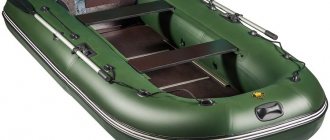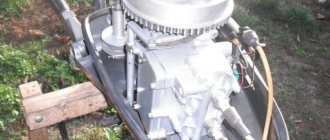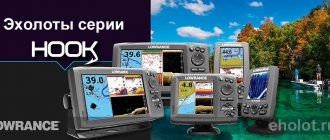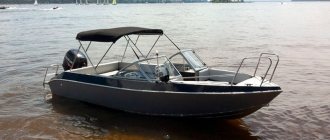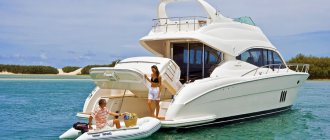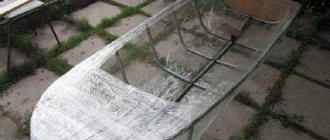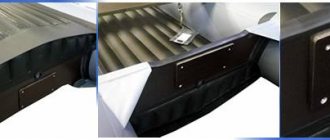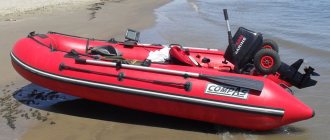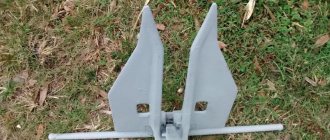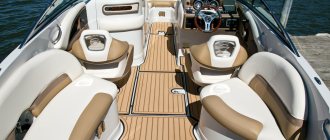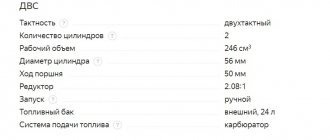Description of the boat "Progress 2"
Boat Progress This water transport was developed by L.P. Zimakov in 1966.
Production capacities were established at the Kuibyshev plant, which specialized in aircraft technology. In those years, the boat was especially popular among fishermen and tourists. In some cases, the unit was used for racing on water. Unlike its predecessor, the Progress boat, the Progress 2 model was made of duralumin. As a result, the motorboat has become more resistant to electrochemical corrosion. This had a positive effect on the service life of water transport. There were various configuration options. For an additional fee, buyers could control the boat remotely. There were also soft seats and a tension awning that was used in the rain.
The components of the boat hull are connected to each other with rivets. The thickness of the body elements on the bottom is 2 mm. The thickness of the sides and deck is 1.5 mm. The boat floats confidently and steadily due to its sealed compartments. They are located in the rear and front of the Progress 2 motorboat (in the bow and stern). There is a trunk, where it is very convenient to put what you need on a trip. It is located in the forepeak.
If you sail a boat using oars, the rower is located precisely on the trunk lid, which folds down onto the bow. The legs fit into the trunk itself. Thanks to this decision by the engineers, the boat behaves steadily on the water while rowing. In this case, the rower does not feel any discomfort. Fuel reserves are usually stored in the engine compartment (near the transom of the boat). In parking mode, the motor can easily fit there.
To protect property, the engine compartment is locked with a key. The seats, which are trimmed with pine slats, are located in the cockpit. Its dimensions are 1.3x2.15 m. When it’s time to sleep for the night, the backs of the front seat serve as headrests. Non-bulky, pocket-sized items can be placed on two shelves located below the deck.
Contours of the Progress-2 motorboat
The body is of riveted duralumin construction; the thickness of the bottom plating is 2 mm, the sides and deck are 1.5 mm. Body weight - 180 kg. Unsinkability is ensured by sealed compartments located in the bow and stern. Luggage storage is provided in the forepeak. When rowing, the rower sits on the trunk lid folded toward the bow, with his legs lowered into it. Thanks to this, according to the designers, the stability of the boat on course and the convenience of rowing are achieved. At the transom there is an engine compartment in which fuel tanks are stored while underway, and a boat motor can be stowed when parked. The compartment is closed from above with a duralumin lid, which can be locked with a padlock. The cockpit, measuring 1.3 x 2.15 m, houses seats covered with pine slats. The backrests of the front seat are removable and are used as headrests when equipping the cockpit for overnight accommodation. Along the entire length of the cockpit below the deck there are two shelves for storing small items.
The boat's disadvantages include splashiness when sailing in fresh weather, the lack of a self-draining engine niche, and the poor quality of the awning fabric. Operation of the boat is allowed at a distance from the shore of up to 3 km and a wave height of up to 0.75 m.
Family of boats "Progress"
Boat Progress 2
There are the following models of motor boats: “Progress”, “Progress 2”, “Progress 2m”, “Progress 3m”, as well as “Progress-4” and “Progress-4L”.
They all have some differences among themselves. For example, “Progress”, unlike “Progress 2m”, does not have a self-draining recess. The space on the sides of the recess is covered with special covers.
These covers allow access to the space directly below the recess. It is convenient to store fuel containers there, the volume of which does not exceed 20 liters.
Large gas tanks are usually located under the rear seat. The next difference of the Progress 2m is one front hatch latch. The “ancestors” had two latches.
In turn, Progress 3 did not have any technically complex improvements when compared with the Progress 2 boat. There are only cosmetic improvements.
It is worth highlighting the placement of railings in front and along the sides on the third “Progress”. Basically, most of the Progress aluminum boats are similar in appearance.
Minuses
And yet, the hull of Progress -4 lacks rigidity. Sometimes you just feel, how to put it this way... certain longitudinal movements of the body when driving under a powerful (for him) engine (50 hp). This is a consequence of the P-4 compromise set - there are no stringers at all, only flora (unlike Progress-2, by the way). But on the other hand, the metal on the bottom is thicker, and “Progress” was designed, by and large, for 30 hp.
Another fly in the ointment is a weak transom. It definitely needs to be strengthened. Entire guides on forums have been written about how this is done, so we won’t go into details.
Technical characteristics of the Progress 2 boat
Motor boat Progress 2
- The weight of the Progress boat is 223 kg (with equipment).
- The maximum load capacity is 500 kg.
- The motorboat can accommodate 5 people at the same time.
- The manufacturer recommends installing an engine with a power of 30 units.
- The deadrise strike is 7 degrees.
- The main largest dimensions of the Progress 2 boat: length - 4.65 m; side height - 0.65 m; maximum length is 1.70 m.
Characteristic features of Progress 2
A year after Progress was admitted to mass production, specialists from the design bureau began modernizing the boat . In Progress 2, instead of steel keel linings, they began to install duralumin ones. This solution protected the keel from destruction by corrosion. The boat was equipped with:
- Control panel.
- Removable awning.
- Seats with soft coverings.
- The wheels are under the carrier.
Additional parts were paid separately; the buyer chose a complete set. The motorboat went on sale with the following technical characteristics:
- Maximum length – 65 m .
- Overall width – 7 m .
- The height of the sides is 65 m .
- Weight with equipment - 223 kg .
- Passenger seats - 5.
- Load capacity – 500 kg .
- Engine power – 30 l/s .
The designer, by removing stainless steel from the keel, increased the service life with duralumin linings. The steel rusted, the owner had to repair the hull more often . In addition, the sealed compartments in the floating craft were replaced. Foam blocks placed around the body saved space and increased reliability. They continue to experiment with tuning on the boat:
- Strengthen the transom.
- Install additional electrical components.
- Change the shape in the windshield.
Progress 2 is still popular among fishermen.
Advantages and disadvantages of the Progress 2m motorboat
Looking ahead, it must be said that there are more advantages.
These include the high reliability of the boat, simple operating conditions, high maneuverability and carrying capacity.
The main advantage, perhaps, is the reasonable price. Today you can buy a motorboat in maintained condition for $1000-2000.
A more accurate price depends on the technical condition of the water transport. The disadvantages include the quality of the awning, which is made of tarpaulin.
Options
The thickness of the bottom plating is about 2 mm, and the sides on the deck reach 1.5 mm. The maximum length is 4.69 m, the width reaches 1.72 m. The height of the sides of “Progress 4” is characterized by a size of 0.69 m, there is a set of sleds, a hook, a bailer, a fire-fighting felt, etc. Technical characteristics for This assumes a load capacity of 475 kg.
The bottom deadrise angle is 7 degrees. The body weight is 180 kg for the Progress 4 model. Technical characteristics of the boat weight are considered in loaded mode. With a full set of equipment it is about 283 kg. That is, on board, in addition to the main gear, you can accommodate a weight of 192 kg, which is stipulated by the technical characteristics and dimensions of Progress 4.
Unsinkability is ensured by sealed compartments at the bow and stern. The technical characteristics of the Progress 4 boat provide for storing the motor in the transom when it is on the shore.
Tuning the Progress 2 boat
Tuning the Progress 2 motor boat
Time-tested Progress boats are durable and reliable, serving their owners for decades, so tuning the vessel remains a pressing issue.
Most often, owners think about strengthening the transom and replacing the seats with more modern ones with soft, beautiful upholstery. Adds unsinkable blocks.
With a more radical approach, the instrument panel is improved, the hull is lengthened, widened, and sometimes a wheelhouse is installed.
It is recommended to place the cabin further from the bow. The wheelhouse shifted forward makes the vessel heavier and slower. The length of the new part must be at least half the length of the superstructure.
During tuning, running and transportation awnings are made for the boat, and windshields are modified.
The rear sofa locker is often replaced with removable seats or a sofa to increase the cockpit during fishing and the possibility of use on the coast.
The deck of the bow compartment is sometimes cut out according to individual orders and requests to expand the space and change the design.
Stripping the hull to bare metal and repainting the Progress give it a completely different, modern look. The boat is equipped with the best motor. Install an advanced audio system.
Motor boat Progress-2
The project of the Progress-2 motor boat was developed by L.P. Zimakov in 1966. This vessel differs from the next model - the Progress-4 motorboat - in the shorter cockpit length (by 0.25 m) and the deadrise of the bottom, the lower chine at the stem, as well as the shape of the windshield and some other equipment details. The performance and operating characteristics are almost identical to the Proress-4 motor boat model. In addition, depending on the type of equipment, for an additional fee it is possible to install a remote engine control, soft seat cushions, an awning, and so on.
The hull of the Progress-2 motor boat was manufactured from duralumin with riveted construction. The thickness of the bottom is 2 mm, the deck and sides are 1.5 mm. Unsinkability is ensured by sealed compartments, which are located both in the stern and in the bow. The forepeak is equipped with a luggage compartment. In the transom area there is an engine compartment for storing fuel tanks or an additional engine. From above, this compartment is closed with a duralumin lid, which can be locked with a padlock. “Progress-2” has a cockpit measuring 130*215 cm; there are seats lined with pine slats. In addition, the front seat backs are removable, which allows you to equip the cockpit for overnight stays.
Below the deck, along the entire length of the cockpit, there are two shelves used for storing various things. Among the disadvantages of the Progress-2 motor boat, it is necessary to note such as splashing in windy weather, as well as the absence of an under-engine recess niche. The operation of a motorboat allows a three-kilometer distance from the shore with a wave height of up to 75 cm. The main advantage of the “Progress” series of boats, which made it possible to win the special love and veneration of powerboaters, is its significant capacity, superior not only to the “Kazanka”, but also to other very popular boat models. That is why “Progress” was popularly called a “family” boat. It should also be noted that due to the fullness of the contours of the bow and the significant width of the hull, the Progress-2 motor boat does not capsize in waves, even though its contours have a “rounded” shape.
As for the shortcomings, the “Progress”, produced before 1975, had a zygomatic pad at the joints of the side and bottom sheets, made of stainless steel, which led to the development of electrochemical corrosion, and, consequently, in sea water the hull quickly became unusable . However, this problem was eliminated thanks to the installation of an aluminum zygomatic pad.
The Progress-2 boat was developed in 1966 by designer L.P. Zimakov. The model is popular in the Moscow region due to its high technical characteristics and affordable cost. Externally, the vessel is similar to the Progress-4 motor boat, but differs due to the reduced cockpit length, modified hull shape and small dimensions. Design Features:
- the body is made of riveted duralumin;
- sealed air compartments prevent the boat from sinking;
- there is a luggage compartment on the forepeak;
- The engine compartment and fuel tanks are installed near the transom. An aluminum lid covers the top;
- the backrests on the front seats can be removed, this will allow you to relax comfortably right in the middle of the pond after fishing;
- Below the deck there are two shelves for personal belongings.
Reviews of the Progress-2 boat often mention such disadvantages as the tendency to splash in windy weather and the lack of a recess under the engine. But this does not prevent the craft from moving freely in the sea at a distance of up to 3 km from the coast and with waves no higher than 75 cm.
The Progress-2 boat has been discontinued from mass production, but you can still buy it on Avito. Often the appearance of purchased boats leaves much to be desired, and damage to the hull prevents them from going out to sea or taking a boat trip on the river. Our tuning service will help eliminate malfunctions and restore an attractive appearance. We produce:
- installation of remote steering;
- replacing seats with more comfortable ones;
- fixing the awning and other accessories;
- restoration of the integrity of the hull;
- painting and styling.
If necessary, we will make adjustments to the standard drawing taking into account the characteristics of the boat. So that you can see the results of the tuning, we have posted a photo of the finished work performed by our craftsmen.
Speed
As a standard, the Progress 4 motor boat, the technical characteristics of which allow it to accommodate a maximum of 5 people on board, is equipped with a Vikhr-M motor. When fully loaded, it allows you to reach a speed of 22 km/h. The engine propeller has a standard diameter of 240 mm (D) and a blade pitch of 300 mm (H).
Sometimes, wanting to increase speed, users replace the motor with a Whirlwind-30. In this case, the speed of the boat will be from 32 to 40 km/h, depending on the presence of luggage.
For the cargo version of the “Vikhr-M” motor boat “Progress 4”, the technical characteristics and dimensions of the propeller should be: D=240 mm, H=240 mm, then the speed will be 33-34 km/h.
The Whirlwind-30 engine should optimally have a propeller D=240 mm, H=282 mm. Its speed at the moment of full load then increases to 39.5 km/h.
If the motorboat has two 25 hp engines. With. power, it can reach a speed of 52 km/h.
